10 Mistakes To Avoid Growing Cannabis Indoors

.
Growing Cannabis can be a straightforward task, that is highly rewarding and educational. However, there are many blind spots and bad habits the untrained grower can fall into which will only ask for problems later down the line, so below are 10 common mistakes to avoid when growing Cannabis indoors and bad habits to avoid in 2020.
1. Keeping Pots On Cold Floors
It is very important to always consider what temperatures the plants are experiencing, and especially in the root zone. As hot air rises and cold air falls to the ground, it is a safe bet to say the coldest point in the entire grow room will be from the floor.
Keeping pots off the floor is an excellent way to improve air flow, as a result increasing the temperatures around the roots. By doing this will also improve drainage, increase the amount of air displacement after waterings and most importantly will prevent cold temps at the base of the pots. Something as simple as a few pieces of wood will suffice, or if you have a large metal fence net you can rest the pots on, then this works brilliantly also.
Adding a heater to the grow room, that is able to be oscillated around the room by fans working at different speeds and settings, will also increase the room mass and allow warm air to pass through the root zone, creating the ideal environment for beneficial bacteria and fungi. Root hair will be encouraged to grow towards the air and as a result will prune themselves, increasing root mass further.
2. Over Watering Plants
It is easily done and can often times become the start of many problems. Not only can overwatering cause the roots to lock out and no longer uptake nutrients, it can also promote ideal conditions for bad bacteria responsible for root rot to thrive.
How long it takes for a growing medium to dry out completely is down to a number of variables from the room temperature, number of lights and how much perlite, or air pocket rich substrate has been added. A great tip if you are growing with organics and are only using plain water, is to set up an irrigation timer that will drip feed your plants a specific amount every day at the same time. This is also a fantastic way to ensure the plants are never overwatered, and can be maintained with you being away from the garden.
3. Big Canopy and Little Air Flow
Having a huge canopy with very little airflow beneath the top section, is only asking for problems later on with pathogens and potentially insects.
Pruning your plants just before switching your timers to 12/12 is a great way to improve air flow, and allow the plant to focus its energy on the upper remaining growth. The result once the plants are ready to harvest is a 12-18 foot canopy of prime buds. Another benefit to removing a large amount of foliage is to reduce the areas that spider mites may live, as the thickest parts of the canopy will also be the warmest and most humid.
[caption id="attachment_11427" align="alignnone" width="780"] Indica cannabis will grow short and uniform with big tops.[/caption]
Indica cannabis will grow short and uniform with big tops.[/caption]
4. Not Storing Nutrients Properly
Many nutrients bottles will state to keep cold floors, however many growers are in the habit of having a corner on the floor dedicated to their nutrients. The best way to store nutrients is to keep them high off the floor, on a shelf or in a box, away from direct sunlight.
Cold temperatures can have a negative effect on the quality of the nutrient, and when dealing with organic matter such as humic or fulvic acids, seaweed and molasses, it is best to keep them from becoming cold or experience frequent temperature changes. Simply build a small shelf and a top tip is to clean all of your organic nutrients after using and wipe the bottles until totally clean.
5. Developing Root Bound Plants
We often don't pay attention to what is happening beneath the top of the pots, which can result in plants becoming root bound. When this happens, the growth of the plants become restricted and may stunt in some cases, until it has been repotted.
The best way to avoid experiencing root bound plants, is to use fabric pots, or plastic air pots designed to let the roots grow in al directions freely. This action prevents the tap root searching around the base of the pots for air, causing the root zone to grow with a prolific structure. If you do experience root bound, spiralling roots then you can simply break them apart with your hands. Do not worry about the roots and feel free to tear the root mass as much as possible. This will only increase the root mass once it is contact with the new growing medium.
6. Foliar Spraying During Flowering
This is one way to ensure your plants will develop powdery mildew and mould when they are blooming. Poor air quality, lack of air flow and high humidity equal breeding grounds for pathogens and insects.
The best time to foliar spray your plants is during the 18/6 cycle, however avoid spraying late just before lights out. It is during the night time when growers turn off oscillating fans and run the risk of stagnant air pockets, which is why a thick canopy with little air flow can cause problems. In the event of an airborne pathogen entering your garden during the blooming period, then it must be treated, yet the most important thing is to make sure it does not happen again, and the prevention becomes the cure. Adjust your environment so the humidity levels do not climb above 40% and keeping exhaust and oscillating fans on 24/7.
[caption id="attachment_11429" align="alignnone" width="780"] This Plant has a serious algae problem around the roots.[/caption]
This Plant has a serious algae problem around the roots.[/caption]
7. Training Plants in 12/12
When Cannabis plants are growing under 18/6, they will respond by producing vegetative growth. One way to enhance the productivity of a strain can be to apply training techniques such as L.S.T, topping, fimming and pruning.
Applying low and high stress techniques once plants have begun flowering, can be counter productive and may even stress the plant. It is during this point when growth hormones are released which is what causes the stretch in the first place.
Always perform training during weeks 2-4 of the vegetative stage, and prune the plants with 7 days prior to 12/12. This will give the plants plenty of time to fully recover and prepare to produce heavy yields.
8. Letting Plants Touch The Walls In Flower
If you are growing indoors using a mylar tent, or have converted a spare bedroom or cupboard, no matter what the size of the room you should avoid letting plants touch the walls. It is on the walls where moisture can build up and air flow becomes restricted once plants begin to grow up against a wall.
Always keep plants well away from walls or sides of tents, especially when they are producing buds. Give yourself a clear parameter around the outside of the tent, for you to be able to walk through if necessary as well as enhance the aeration around the sides of the garden. When buds comes into contact with walls due to excessive weight, this is a red flag for mould to start growing and eventually spread to the rest of the plants.
9. Keep The Grow Room Tidy!
One common theme when I enter another person’s grow room is how untidy they are. Keeping old nutrient bottles, harvested plant pots with growing medium in, dirty towels and general rubbish around your grow room is a bad habit,. Not only is it asking for insects and flies to enter the grow room, it is also unprofessional and not to the standard a grow room should be kept in.
It does not cost much to buy a dustpan and brush, mop and bucket, plastic rubbish bin and some cleaning products. Make sure the floor is spotless and sweep and mop with bleach once a week to maintain a sterile environment. Throw old nutrient bottles into the bin, and get rid of any plant pots that were harvested but later neglected.
[caption id="attachment_11428" align="alignnone" width="780"] Always be vigilant and check on the condition of your root zone[/caption]
Always be vigilant and check on the condition of your root zone[/caption]
10. Noisey Gardens
It can be difficult to estimate the amount of industrial sounding noise, all of your equipment will create once you have everything set up. Exhaust fans, intake fans, oscillating fans, wall fans, air pumps and water pumps can make a serious noise once all fired up, and as you will usually keep all of the above switched on for 24 hours a day, controlling the noise output of your garden is very important, especially if you have close neighbours or are living in a residential block.
It is possible to soundproof the grow room using things such as acoustic ducting, silencers and custom sized acoustic wooden boxes for exhaust fans. Of course, discretion is the name of the game, so keeping the noise of your indoor garden to a minimum is key, and will help keep your neighbours off your back.
My Conclusion:
When growing Cannabis, taking the extra time and steps to keep the grow room as clean as possible, and the airflow consistently as maximum as possible 24/7 will pay off massively. Making very simple adjustments such as raising pots a few inches off the floor making sure the bottoms of the pots are exposed to the air, or pulling plants away from the edge of the walls will cost nothing and will make huge improvements to the air capacity and reduce the risk of pathogens.
Pay attention to the temperatures of the air, root zone, nutrients and if possible invest in a hygrometer that will display the temperature and humidity, as well as the lowest and highest record for that 24 hour period. During flowering, anything above 40% humidity will cause you to run the risk to spider mites, or plant disease that need that specific humidity level to survive.
Use pots designed specifically for root pruning, or simple fabric pots. It is possible to grow an enormous plant in a fabric pot, with an extremely advanced root zone. There is no need to replant or worry about the tap root growing round and round. Good luck with your indoor operations and I hope these 10 pointers will help take your grow game to the next level.
Peace Out!



.png)